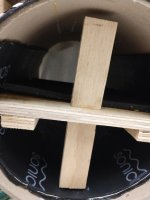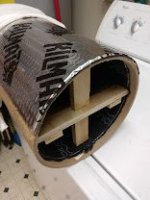Interesting…I’ll be honest, I had to Google reactance anulling. The idea that it is a capacitive and inductive equation to solve is alien to my mind.
I never really understood what was going on when one was trying to “tune” a back chamber. I just thought if you did it correctly it would give you a smoother response and possibly some more low frequency extension?
I wonder, if the goal is to balance out the resistance of the horn/waveguide on the front of the driver with a back chamber if its all trial and error anyway?
A transmission line on the back of the driver seems like an exotic solution, it does not sound like a simple solution logistically or regarding design, construction and tuning. I doubt I would be able to design and tune one so that it would supplement the bottom end and then hand off to the front horn properly.
I’m not sure one could really mimic transmission line with a cylindrical back chamber and some resistive stuffing?…but it’s a simple enough idea to try.
I never really understood what was going on when one was trying to “tune” a back chamber. I just thought if you did it correctly it would give you a smoother response and possibly some more low frequency extension?
I wonder, if the goal is to balance out the resistance of the horn/waveguide on the front of the driver with a back chamber if its all trial and error anyway?
A transmission line on the back of the driver seems like an exotic solution, it does not sound like a simple solution logistically or regarding design, construction and tuning. I doubt I would be able to design and tune one so that it would supplement the bottom end and then hand off to the front horn properly.
I’m not sure one could really mimic transmission line with a cylindrical back chamber and some resistive stuffing?…but it’s a simple enough idea to try.
Most of the commentary here is very close to being 100% spot-on. But, please allow me to expand on this. A cardboard cylinder is indeed non resonant, but does have a "sound". We want 100% neutral. I used damping sheets on 1/2 of the outside, and then on the inside for the opposite half. A cylinder has a constant axial mode, so we want to eliminate that by using a "septum". The pictures are as viewed from behind, a.k.a. the exit to the world outside, but before absorbent material has been installed. !00% we want to emulate a quasi-transmission line, but not too much stuffing!! We only want delay (as has been mentioned previously) The septum should be cut to the dimension to where it barely touches the back of the driver, and does not block voice coil vents, if they exist. Again, this is NOT reactance nulling. The mass load, should by rights, affect the free air resonance, but not to a significant degree. The signal to the horn should be bandwidth limited- hi pass, as we don't' want to ask more of the horn than is possible. I have gotten great results from this method, I hope you all do, too.

